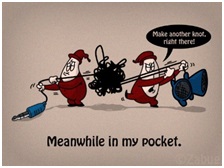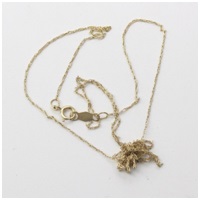A Coaching Model Created by Camille Gold
(Communication and Relationships Coach, UNITED STATES)
 Have you ever been in the process of going out for a walk or a run and, as you pull your sneakers from under your bed, you find the laces tangled in knots? Maybe you want to listen to some music, an audiobook, or a podcast, so you reach into your pocket to pull out your headphones and find them all tangled up. Perhaps you are going out for the evening and you want to wear your favorite gold chain, but you find part of it snarled together in a clump. Your progress becomes halted, interrupted, snagged and you are faced with a decision: how will you deal with this? It takes time to untangle chains, headphones, or shoelaces, but if you want to move forward you must spend the time to get things untangled.
Have you ever been in the process of going out for a walk or a run and, as you pull your sneakers from under your bed, you find the laces tangled in knots? Maybe you want to listen to some music, an audiobook, or a podcast, so you reach into your pocket to pull out your headphones and find them all tangled up. Perhaps you are going out for the evening and you want to wear your favorite gold chain, but you find part of it snarled together in a clump. Your progress becomes halted, interrupted, snagged and you are faced with a decision: how will you deal with this? It takes time to untangle chains, headphones, or shoelaces, but if you want to move forward you must spend the time to get things untangled.
Our hearts and minds function in much the same way. Sometimes we find ourselves wondering, “Why can’t I move forward?”; “Why can’t I do this?”; or “Why do I keep tripping up?” Our progress has become halted, interrupted, snagged by tangles in our thinking. The problem is that thoughts drive our emotions, and those emotions often drive our actions. So, when we find our thinking tangled up in some way, there is a rippling effect of feelings and behaviors that stop us from moving forward in our lives and relationships.
Awareness
When there is a knot in lace, a cord, or a chain, the first thing that needs to happen is awareness. Recognizing the fact that optimal progress with the most ease can only occur when things are sliding along smoothly is the first step toward becoming free of tangles and knots. You could wear that gold chain while it has a knot in it, you could put on your shoes while the laces are tangled, and you can listen to music with headphone cords bunched in a complicated mess, but your enjoyment levels may drop significantly.
In our lives and relationships, we need to become aware of those things that are impeding progress and dropping the levels of enjoyment, satisfaction, and happiness we want to have. Coaching is a great way to gain that awareness and uncover what is most important to you. Through direct communication and powerful questioning, a skilled coach can help you to clarify questions such as:
Gaining awareness can help you to visualize where you want to be and help you to acknowledge the things that might be creating tangles that stop your progress.
Curiosity and Freedom
 When you’re working to untangle a knot in the chain of a necklace or one of the other stringy things in your life, you have to become curious about the knot itself in order to find the way to smooth it out. “Is this loop connected to that loop?” “If I move this strand, does it tighten the knot or loosen it?” In the same way, a coach operates from a place of curiosity about you, their client. The coach is not meant to sit there and tell you which string to pull or which loop to widen because the coach knows that you’ve got this – you’re a capable person who has all the answers within yourself. A masterful coach will ask questions to help you workshop your goals and plans, to help you discover the answers awaiting within. They will also challenge your views in order to identify limitations that might be perceived, but not really.
When you’re working to untangle a knot in the chain of a necklace or one of the other stringy things in your life, you have to become curious about the knot itself in order to find the way to smooth it out. “Is this loop connected to that loop?” “If I move this strand, does it tighten the knot or loosen it?” In the same way, a coach operates from a place of curiosity about you, their client. The coach is not meant to sit there and tell you which string to pull or which loop to widen because the coach knows that you’ve got this – you’re a capable person who has all the answers within yourself. A masterful coach will ask questions to help you workshop your goals and plans, to help you discover the answers awaiting within. They will also challenge your views in order to identify limitations that might be perceived, but not really.
At the same time, the coach provides a space where you can be free to explore all of those things, to explore the loops and strings in your life and relationships. In this day and age of near-constant talking, posting, and sharing, it’s easy to feels that no one is really listening. A coach provides that deep, active listening in an atmosphere of trust that gives you, their client, the freedom to explore possibilities, to workshop ideas, and to take time–without judgment–to unravel knots that might be slowing you down.
Action and Accountability
Clearly, if there is no action the knot will never be untangled. Without action, no amount of awareness, curiosity, or freedom will get the strings to move smoothly across each other. Sure, you could throw the knotted shoes, the tangled headphones, the jumbled necklace in the trash, but would that really serve you when you have a different pair of shoelaces to deal with? Another set of headphones? Another necklace?
 Similarly, in your own life you could discard a relationship, smother thoughts, anesthetize feelings with some form of self-medication, but would that really serve you to reach your best potential? A coach will work with you to untangle the knots in your thinking and relationships, to answer questions like these:
Similarly, in your own life you could discard a relationship, smother thoughts, anesthetize feelings with some form of self-medication, but would that really serve you to reach your best potential? A coach will work with you to untangle the knots in your thinking and relationships, to answer questions like these:
The coach will also encourage you to be accountable to yourself, to set a structure and/or timeframe within which to take the action you’ve chosen. A coach can be an advocate, a cheerleader, a sounding board, a supporter, a truth-teller, and an accountability partner. Without accountability, the action doesn’t have much meaning.
Tangle-Free Tapestry
Now, having accountability doesn’t necessarily include an assurance that you’ll never become tangled again. Our thoughts lives and relationships are destined to become tangled, just like the laces on our shoes or the headphones in our pockets. From an article on scienceabc.com, we learn about Knot Theory:
It was the year 2007 when two physicists decided to take a fresh look at this modern-day problem. Physicist Douglas Smith and his then-undergraduate student Dorian Raymer performed experiments by placing a string into a box before tumbling the box for about 10 seconds. They performed this experiment roughly 3,000 times with strings of different lengths, boxes of different sizes, and varying rotation rates of tumbling. They applied the famous knot theory to their results and published their study in the paper: “Spontaneous knotting of an agitated string”. In the study, they found that almost 50% of the time, the string would form a knot by itself.
Life is messy. Relationships are complicated. Thoughts are being tumbled in our minds all day long. Science and experience tell us that we’re going to get tangled, snagged, halted, knotted up. The great news is that you don’t have to do it alone. Coaching is an excellent resource to smooth the strings that create the tapestry of our lives.
Resources
Vinod, Ashwin. “How Does an Earphone Get Tangled Up All By Itself?” ScienceABC.com. 26 August 2015, updated 19 April 2018. www.scienceabc.com/pure-sciences/how-does-an-earphone-get-tangled-all-by-itself.html. 14 November 2019.